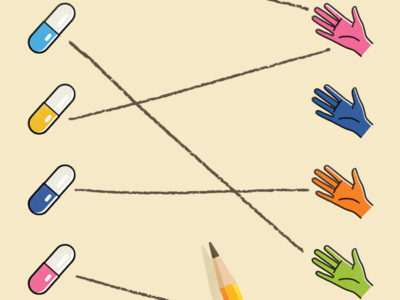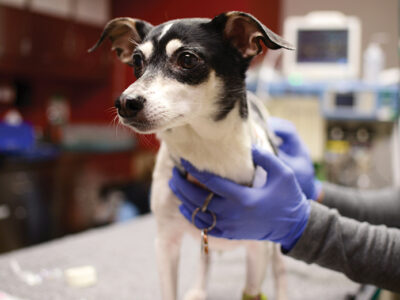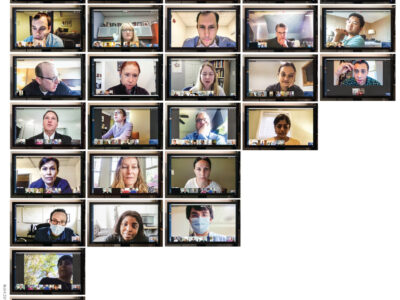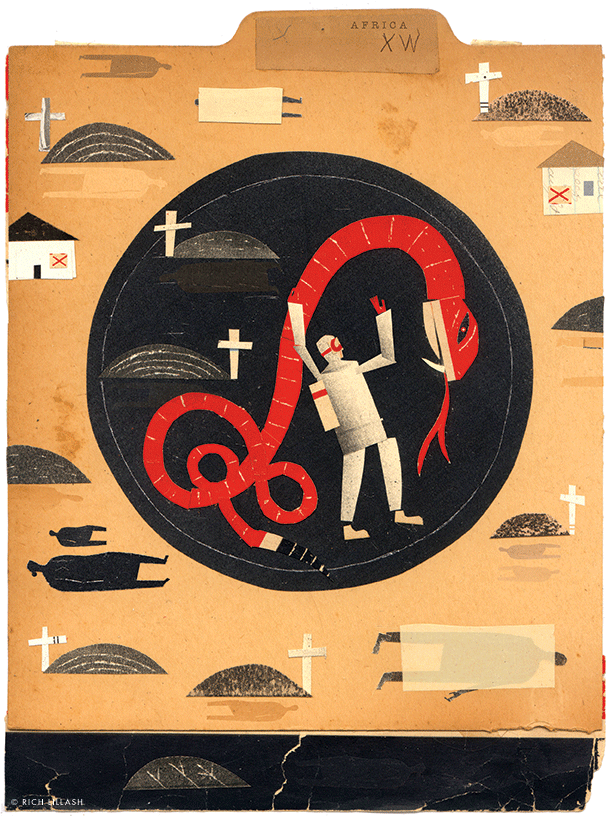
They tend to be uncomfortable with terms like “fighter” and “hero,” but it’s hard to know what else to call these alumni and staff volunteers who’ve traveled to the heart of the epidemic to do whatever they can to help its victims.
BY MELISSA JACOBS
Illustration by Rich Lillash
Photography by Jim Graham
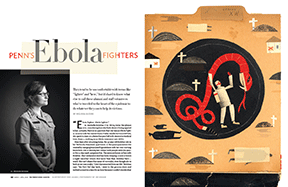
Ebola fighter. Ebola fighter.”
Lt. Michelle Holshue C’07 Nu’09 turns the phrase over, considering how she feels about it being applied to her. Actually, there is no question that she was an Ebola fighter. A nurse with the United States Public Health Service (USPHS), she spent 62 days in Liberia this past fall with Monrovia Medical Unit, Team 1, working in an Ebola treatment unit (ETU).
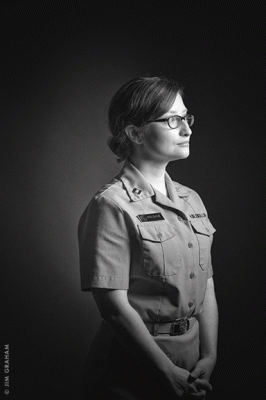
Nine days after returning home, the 32-year old Holshue sits in her Bethesda, Maryland, apartment, in the quasi-quarantine she created by merging Maryland’s guidelines with her own nursing know-how. She is limiting her contact with people until she passes the 21-day mark symptom-free. The semi-seclusion is fine with Holshue. She’s exhausted and has been sleeping 10 and 12 hours a night since her return. But more than that, Holshue feels … weird. She can’t shake this sense of surreality, even though she is back in her own reality. “I feel disconnected from my life,” Holshue says. “My first full day back, I went to the grocery store and walked around in a daze for an hour because I couldn’t decide what to buy.” Part of that disconnection may be because Holshue hasn’t yet talked at length about her experience. She’s not sure that anyone wants to know the truth about what’s been going on in West Africa. It’s happening “over there,” and anyway, there’s nothing that the general public can do about Ebola except donate money to worthy groups, though that’s certainly valuable. She also believes that more doctors and nurses should volunteer to work in ETUs in Liberia, Sierra Leone, and Guinea, and feels that it’s important to “bear witness” to the suffering caused by Ebola. But her time in Liberia has taught her the limits on what healthcare workers can accomplish for their patients in the so-called battle against this epidemic.
“Ebola fighter.”
No, Holshue doesn’t like the term. She doesn’t think that it was much of a fight and if it was, well, Ebola won.
Holshue was no stranger to infectious disease. She is a clinical research nurse at the National Institutes of Health and works with patients who have HIV/AIDS, Hepatitis C, and influenza. That’s her duty station, her “day job” with USPHS, which is a uniformed service of the US Department of Health and Human Services. Its officers—physicians, nurses, psychiatrists, pharmacists—serve in the Centers for Disease Control (CDC), the Food and Drug Administration (FDA), and other public-health institutions. This is the army that the Surgeon General leads.
USPHS also has 41 Rapid Deployment Forces, each made up of approximately 100 officers. They function as medical SWAT teams, responding to public health emergencies created by disease and disaster. In September, USPHS announced that it was assembling Monrovia Medical Unit, Team 1, an extra-special force of 69 people selected from the RDFs. This was the SEAL Team Six of Ebola fighters.
Holshue’s infectious disease expertise qualified her for a spot, as did the work she had done in Honduras and India, and with the Botswana-UPenn Partnership, while a Penn nursing student. When she was accepted to Monrovia Medical Unit, Team 1, Holshue was thrilled. “It was a dream come true for me to be chosen to go—and I know that sounds weird,” Holshue says. “But I thought it would be the opportunity of a lifetime to use my skills to stop the spread of Ebola.
“Jeez. How naive was I?”
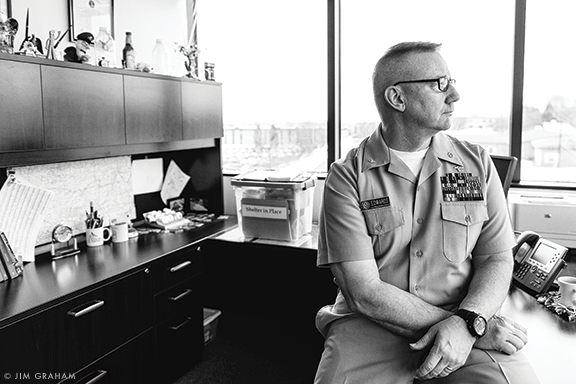
Capt. Calvin Edwards G’12, whose Penn master’s degree is in organizational dynamics, stares out the bedroom window of his Chambersburg, Pennsylvania, house on day eight of his quasi-quarantine. It was Edwards’ team that Holshue joined.
Hurricane, nuclear attack, zombie apocalypse, whatever—Edwards, 51, is the guy who will lead everyone to safety. He has led his team to disaster zones created by the attack on the World Trade Center; Hurricanes Floyd, Katrina, Gustav, and Sandy; and the centers established for unaccompanied minors streaming into the United States from Mexico.
Edwards has served in response teams since 1996 and joined PHS-2 Rapid Deployment Force in 2006; he’s been the commanding officer since 2008. Before joining USPHS, he was a Naval officer, then a health physicist. His specialties include nuclear engineering, industrial hygiene, and environmental health—which translates to keeping the American food and water supply safe from radioactive waste, asbestos, and other contaminants. He normally works in the FDA’s Harrisburg, Pennsylvania, field office, where he supervises a team of investigators who conduct inspections to ensure that pharmaceutical and food firms are complying with regulations. Because of all that experience, Edwards was asked to be the commanding officer of Monrovia Medical Unit, Team 1.
But he didn’t immediately agree to it. This would be the first time that his team dealt with an infectious disease—one for which there is no cure. “To be clear, I wasn’t and am not afraid of Ebola,” Edwards states. “My supervisors and I were confident in my abilities to execute this mission because I’m very qualified to handle this particular crisis. Wearing PPE [personal protective equipment] is not new to me,” he says. “I’ve worn it for years. I know what it can do when donned and doffed according to procedure.”
But that was the problem: procedures for PPE were changing because healthcare workers were being infected by Ebola. When USPHS contacted Edwards about Liberia in late September, Kent Brantly and Nancy Writebol had already been infected with Ebola during their missions to West Africa. Two nurses at Texas Health Presbyterian Hospital Dallas had been infected when treating Ebola patient Thomas Eric Duncan. The question became quite simple for Edwards. Did USPHS or any branch of the US armed forces—or anyone, anywhere—have the equipment and expertise to protect him and his team?
Edwards held high-level discussions with USPHS, but his most important conversation was with his wife, Christine, with whom he has four children. When your country wants you to go a country you’ve never visited to help people you’ve never met who are dying from a highly infectious disease for which there is no cure, what do you say to your wife?
“When I first talked to Chris about it, well, it was … ” Edwards clears his throat several times, then takes a deep breath. “We’ve been married for 29 years. This would be the longest we’ve been separated, and it was a very dangerous situation. But she knows who I am and what I’m all about, so her reaction was, ‘People are dying from this and you can help them. This is your expertise. This is your calling. You have to go. You have to try to stop Ebola.’”
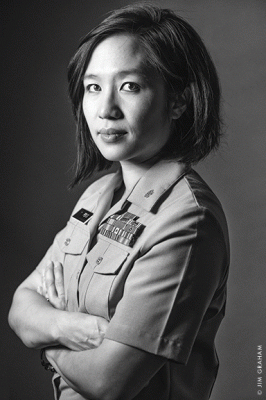
On October 25, Edwards and his team boarded a plane for Liberia. Among them was Lt. Cmdr. Suzette Peng C’97, age 39, a physician with specialties in internal medicine and rheumatology. Her USPHS duty station is with the FDA in Maryland, and she didn’t have experience in infectious disease. What qualified Peng for the team is the 10 years she spent as a US Army doctor. She was stationed at Walter Reed and Fort Belvoir military hospitals, then deployed to Iraq from 2006-2007, spending six months in a combat support hospital in Baghdad and six months in Mosul.
But that was before Peng had children. On day 10 of her quasi-quarantine, she’s in the Maryland hotel room that will be her home until she gets to day 21 symptom-free. Peng isn’t worried about infecting her two kids, ages 4 and 2, but rather that they will infect her with whatever cold is circulating through the toddler set, and that those symptoms will make her Ebola monitors suspicious enough to stick Peng in real quarantine.
With these three weeks and her time in Liberia, Peng will have been separated from her kids for more than 80 days. “That was the most difficult part of the decision to go to Liberia,” Peng says. Why did she go? “First, I thought that my Army background qualified me for this mission. I thought it was my duty and responsibility to go. Second, serving people is why I became a physician, and these people need a tremendous amount of help. And third, Captain Edwards would be the officer in charge, and I knew that we would be well-commanded. I knew that he would keep us safe.”
Here’s how Edwards went about doing that. He got his team the best PPE, then trained, trained, and trained some more. Monrovia Medical Unit, Team 1 spent one week in Anniston, Alabama, at FEMA’s Center for Domestic Preparedness. That’s a gentle title for what the place really is: the Department of Homeland Security’s training center for disasters related to weapons of mass destruction, which Ebola was turning out to be.
The USPHS officers donned and doffed PPE hundreds of times, and they did so in mock ETUs. They also got mobilization training, which includes security briefings and information about the culture of the area in which they would be stationed. Although the mission was being conducted in cooperation with the Liberian Minister of Health and Social Welfare, the entire region was grappling with a full-blown crisis. “It’d be like meeting a new person on the worst day of his life,” Edwards says.
The USPHS team arrived in Monrovia on October 27. Five days earlier, the World Health Organization had issued a report showing that the geography of the Ebola epidemic had changed. Ebola had invaded Senegal and Nigeria. The new total number of confirmed infections was 9,911. The highest number of cases in Liberia were in Monrovia. Edwards and his team were heading straight into the heart of the epidemic.
The Monrovia ETU was not yet operational when the USPHS team arrived. Holshue decided to volunteer at an ETU that International Medical Corps (IMC) operates in Suakoko, Liberia, a three-hour car ride from Monrovia. It is in rural Bong County which, unbeknownst to Holshue, WHO had just reported as having the second-highest number of Ebola cases in Liberia.
The Bong County ETU is made of blue tarps covered in IMC stickers, and it sits at the top of a hill in Suakoko. This is where Holshue met Ebola for the first time. She saw beds filled with infected patients and a morgue filled with those whom it had killed. Holshue says that she wasn’t shocked or scared. She was “deeply saddened. It all became very real for me in Bong.”
Also volunteering in the Bong County ETU was Patricia Henwood, a Hospital of the University of Pennsylvania emergency medicine physician and director of that department’s Global Health Initiatives. Henwood, whose previous experience included working in Haiti after its massive earthquake as well as in very dangerous, very disease-ridden areas of Uganda and Rwanda, got to Liberia on October 17 and spent a month working there.
And another Penn person—Ruth Kauffman Nu’96, who works as a midwife, obstetrics nurse, and Sexual Assault Nurse Examiner in Albuquerque, New Mexico—was among the first Americans to join Doctors Without Borders/Médecins Sans Frontières’s Ebola response. She arrived in Sierra Leone in August, having previously worked extensively with MSF in India, South Sudan, Uganda, Papua New Guinea, Myanmar, Solomon Islands, and Bangladesh.
But here’s the thing about the qualifications, experience, and training of all these men and women. None of it prepared them for the real horror of Ebola.
Numerous media reports on the epidemic have made the trajectory of the Ebola virus familiar to readers: Fever, vomiting, diarrhea, abdominal pain, muscle weakness, joint pain, headache, and sore throat are among the first symptoms. As the disease progresses, eyes turn red and skin sometimes scales or sloughs. Fluids leak from every orifice and there is pain throughout the body. Breathing becomes difficult. Eventually, delirium sets in, which, everyone agrees, is not a bad thing.
Actually bearing witness to this kind of suffering is another matter, of course. And perhaps the only thing more terrible is seeing it happen to a child.
“The children are the toughest part for me,” Henwood says. “They come to the ETU with their parents even if they don’t yet have symptoms because, even if the parents would part with them, there isn’t anyone left alive to care for them. If it’s early enough in the parents’ disease, it may not have passed to the children. But usually it does, and the children have a very high mortality rate when it comes to Ebola. I’m not exactly sure why—I don’t have research to explain it—but my guess is that the viral load is too small for their little bodies.”
As it is with fetuses. That’s the reason Kauffman’s midwifery experience is so needed in Sierra Leone. When pregnant women contract Ebola, it kills their babies even if it doesn’t kill them. “I was able to assist with the births of the first three pregnant women who survived Ebola under care of MSF in Sierra Leone,” Kauffman explained via email. “Sadly all three lost their babies.”
Ebola has killed many, many more babies. WHO doesn’t have the exact numbers but says that no fetuses have survived after their mothers became infected with the virus. Most die in utero; some survive to birth but die immediately afterward. Delivering the fetuses is incredibly dangerous for healthcare workers because of the bodily fluids involved, but that hasn’t deterred Kauffman. “From the end of August through the end of October I conducted birth and supervised the reproductive health unit of Gondama Health Centre in Sierra Leone,” Kauffman wrote. “I also was doing births of Ebola-positive mothers in the Kailahun Ebola Management Center.”
By November 7, Holshue had returned to Monrovia for the opening of USPHS’s ETU. Built by the US Air Force and Navy, the ETU was approximately 200 feet by 80 feet and divided into wards for intake, laboratory, pharmacy, and patient treatment. Before entering it, team members drank one liter of oral rehydration solution, then donned PPE. In Liberia’s 90-plus degree heat it was physically impossible to wear PPE for more than a few hours, if that. Sweat produced condensation that fogged goggles, obscuring vision. Fingers swelled inside multiple layers of gloves. Dehydration led to light-headedness.
At the first signs of impairment, they exited the ETU and went through the decontamination procedure that repeatedly doused their PPE—and their hair and skin—in 0.05 percent chlorine solution. They would hydrate, eat, rest, then don PPE again and go back into the ETU. Each team member worked a 13-hour shift. There were no showers at the ETU, so Holshue, Peng, and their colleagues rode a bus back to their barracks in full stink, traveling 45 minutes down bumpy, dusty roads. Even when they did shower, they had to keep their mouths closed because the water wasn’t potable. They had bottled water to drink, MREs to eat, and cots on which to sleep. But the barracks were adjacent to an active airport and noise was almost constant, as was the heat. They slept in batches, Holshue says, letting their muscles rest even if their brains couldn’t.
This was the USPHS team’s routine six days a week for six weeks. They left Monrovia on December 19. No one is sure exactly how many patients they treated and USPHS isn’t saying. But everyone knows how many patients they saved: four.
“The only treatment we could give them is supportive care, which is IV fluids, magnesium and potassium to prevent dehydration, Tylenol to control the fever, food and oral rehydration solution if the patient can ingest them,” Holshue says. “It was very hard on us that there wasn’t more that we could do for them. All I could do is hold the bucket while they puked into it.”
Peng and Henwood echo Holshue’s frustration. Supportive care did help some patients fight the virus, but both physicians have long wish lists of diagnostic equipment that might have helped them provide better care. “Even in Baghdad, there was more I could do for my patients,” Peng says.
More than the heat and sleep deprivation, this sense of helplessness seems to have had the biggest effect on the healthcare workers. “I will tell you that it had an enormous impact, because their training is to save people, and that was usually not possible,” says Commander Anthony Tranchita. A clinical psychologist, Tranchita is a USPHS officer and the Behavioral Health Clinic Commander at Grand Forks Air Force Base in North Dakota. He went to Monrovia with the USPHS team; Edwards recruited behavioral health specialists for the mission, anticipating that the circumstances would take a psychological toll on his team. Tranchita says that Edwards put an enormous emphasis on providing what sounds like psychological PPE. Of the 69 officers, eight were behavioral health specialists. “We talked a lot about our work being an ethical response, because, in light of all of our limitations, we saw people struggling to call it a medical response,” Tranchita says.
This is why the term “Ebola fighter” feels so wrong to Holshue. Tranchita understands completely. “You can count me as one of the people who deflect that, as well as the word ‘hero,’” he says. “Intellectually, I understand that it is meant as a compliment. But it feels to us like we were inefficient. We didn’t save everyone.”
By mid-January, USPHS members had completed their 21-day monitoring. They were symptom-free and returned to their duty stations. Henwood had returned to West Africa and was working with an IMC team in Sierra Leone. Kaufmann also returned to Sierra Leone; she helped MSF open its first center specifically for pregnant women infected with Ebola.
A ray of good news came from WHO on January 14. Liberia reported its lowest number of new Ebola cases since June, and reports of new cases in Guinea and Sierra Leone were the lowest they’d been since August. It was too soon to say that the tide had turned, but it may have at least been slowed. How? WHO pointed to the new treatment facilities that were built and the proper burial of bodies infected with Ebola. But those already infected with the virus were still dying of it. WHO’s January report showed that 21,296 people contracted Ebola worldwide; 8,429 died of it. That includes 843 healthcare workers who were infected with Ebola, of whom 500 died. Why is the fatality rate higher among healthcare workers than the general population? “They may have gotten a bigger bolus of the disease because they were treating patients in whom Ebola was fully developed,” says Harvey Friedman, chair of Penn Medicine’s infectious disease division for more than 20 years and founder of the Botswana-UPenn Program. “Or it could be for a hundred other reasons that we haven’t yet learned.”
But a lot has been learned, Friedman says. From improved PPE procedures to the new medical facilities in West Africa, he feels confident that the world is now better able to handle an Ebola epidemic. Henwood and Edwards agree with that assessment. It’s also true that this epidemic has reignited research into finding a cure for the disease. But until one is found, Ebola will remain a deadly threat—simmering in pockets of Africa with no one quite sure what to do about it.
Melissa Jacobs C’92 is medical editor at Main Line Today magazine.


